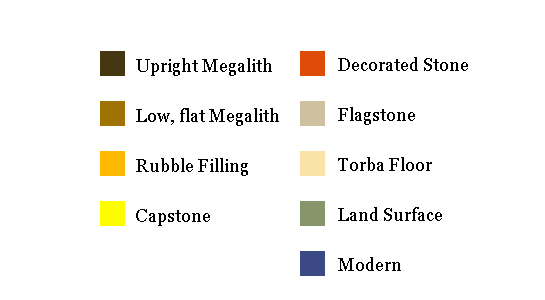

Skorba, like its neighbour Ta’ Hagrat, is on the small side and has not survived the passage of time particularly well. However, it is one of the few to have been excavated using modern methods. The site was identified by Themistocles Zammit in 1914 and partially investigated by his son Charles in 1937 but systematic  excavations did not take place until David Trump began work there in the early 1960’s. It proved to have been occupied throughout the Neolithic Period, from the Ghar Dalam phase right through to the Bronze Age. Prior to the Temple Period it was the site of a small village (discussed in the section Before the Temples) and the foundations of the temple cut through these deposits.
excavations did not take place until David Trump began work there in the early 1960’s. It proved to have been occupied throughout the Neolithic Period, from the Ghar Dalam phase right through to the Bronze Age. Prior to the Temple Period it was the site of a small village (discussed in the section Before the Temples) and the foundations of the temple cut through these deposits.
There are two adjacent temples on the site—a trefoil building, Skorba West (left), belonging to the Ggantija Phase (c. 3600-3200 BC) and a four-apse temple, Skorba East, from the Tarxien Phase (c. 3150-2500 BC). The older one was in a little better shape than its neighbour—much of the back half is still standing at any rate. A paved entrance passage, pierced by five ‘libation’ holes led into a central court with a torba floor. Only a single upright of the original trilithon doorway still survives. The back walls of the outer apses have survived reasonably well, however, along with a pair of large monoliths to either side of the entrance to the terminal apse.


During the initial phase of the temple there were a pair of standing blocks with pitted decoration but during the Tarxien Phase these were taken down and re-laid as a step to the right-hand apse. As part of the remodelling of the temple that took place at this time, two trilithon altars were set up in the apse and a porthole doorway was installed to screen off the space. The left-hand apse was provided with a step but no screen. The central apse, on the other hand, was completely walled off apart from a central doorway, which was flanked by altars—one pair outside and one pair inside the room.

The left-hand apse of the West Temple
At some point during the Tarxien Phase, perhaps at the same time as the other modifications, part of the eastern side of the building was demolished to make way for Skorba East. Unfortunately, this four-apse temple was all but levelled and only the outline of the building and the altar at the rear are visible today. A deposit of debris about 15cm thick was found on the floors of the temple, including the charcoal remains of the roof, which had burned and collapsed into the rooms.

General View of the East Temple



